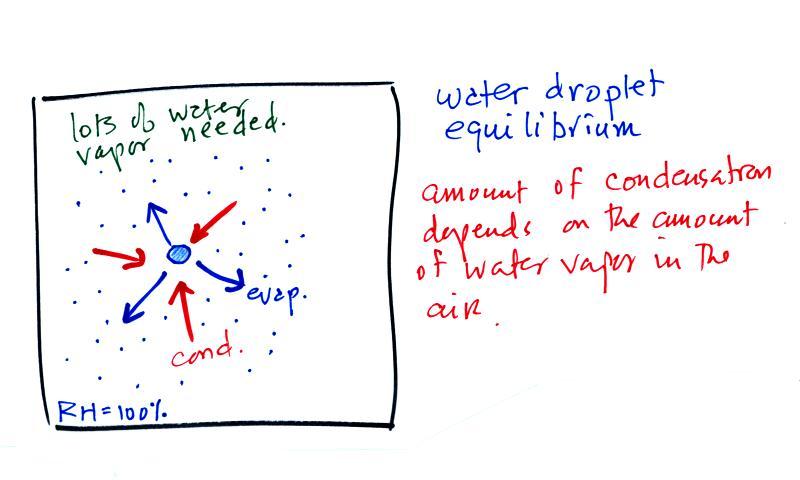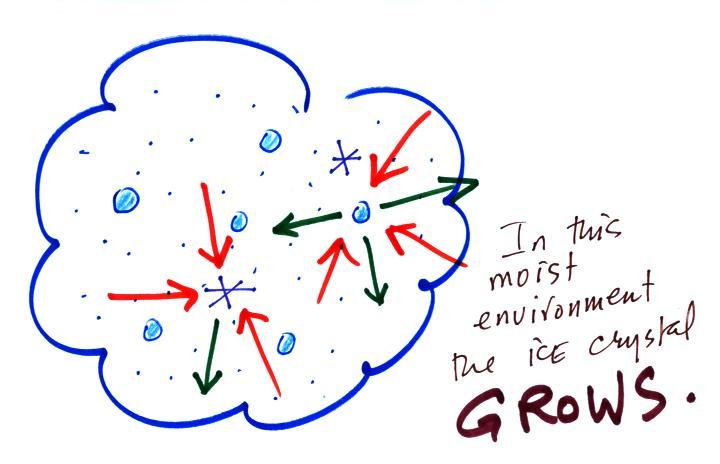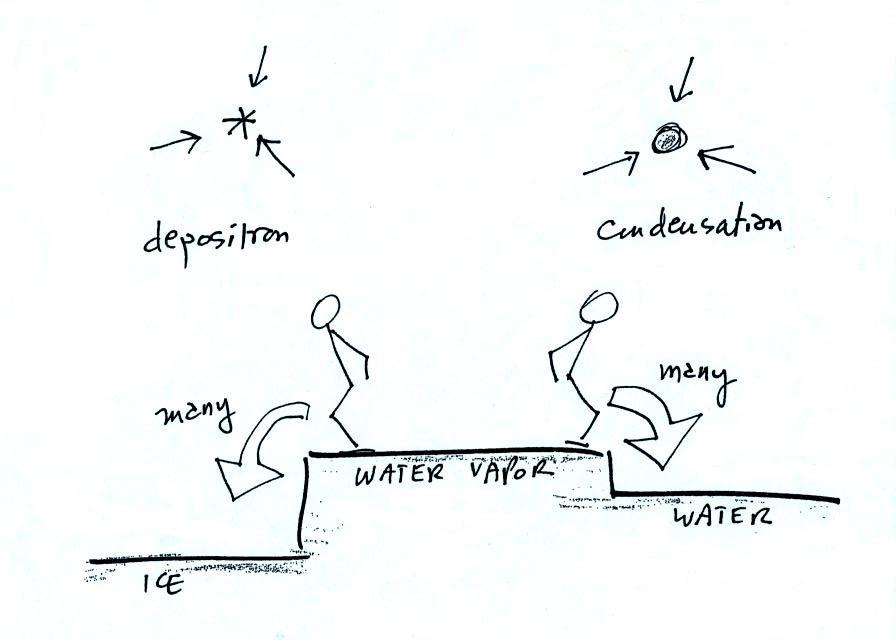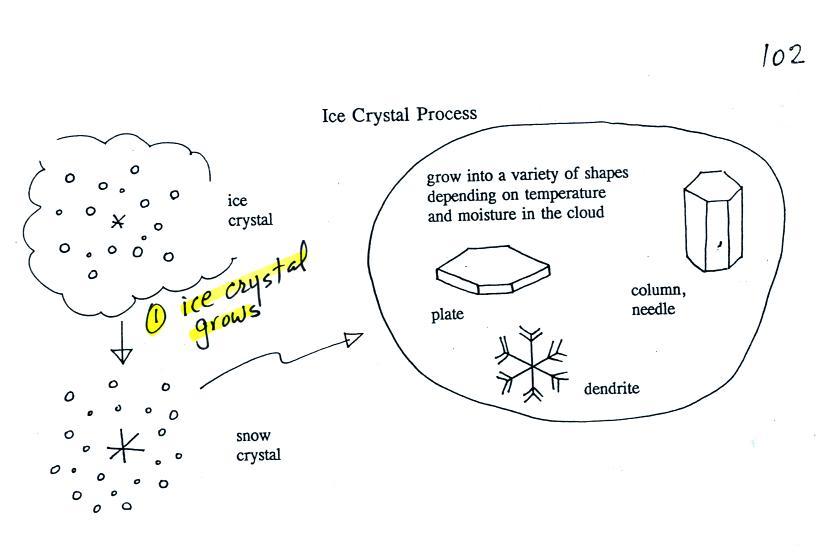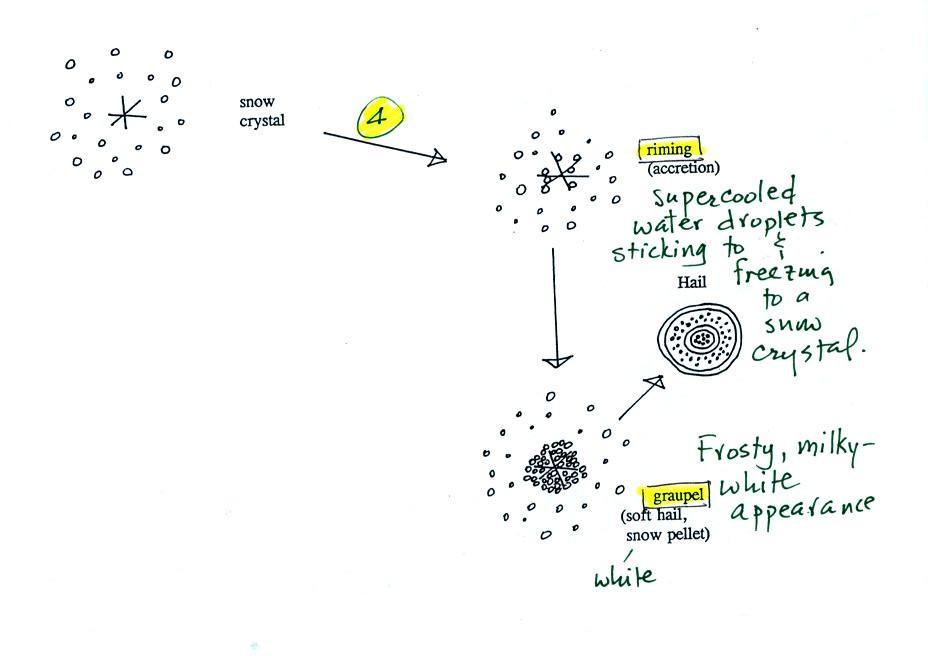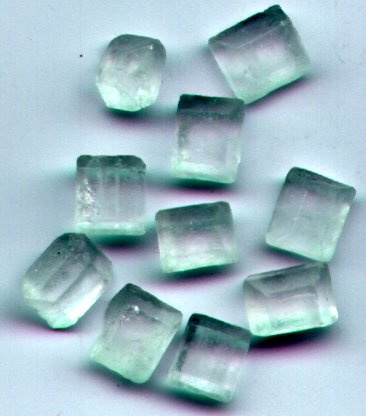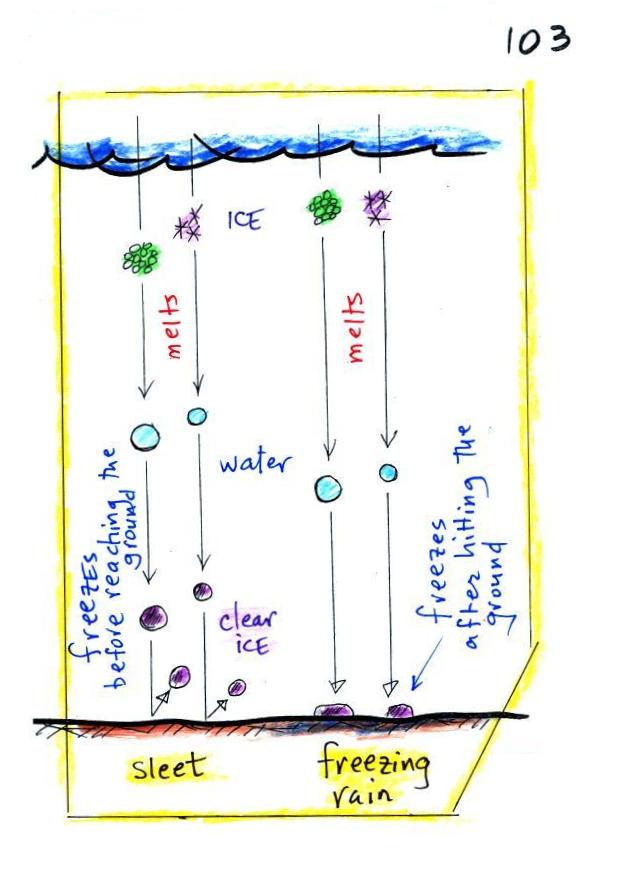Tuesday Apr. 7, 2015
Music from Breaking Bad: Los Cuates de Sinaloa "Negro Y Azul"
(3:23), "Waiting
Around to Die" (5:13) by the Be Good Tanyas, Los Zafiros "He Venido"
(3:18), Cumbre Norteno "Simplemente
Amame" (3:08), "Koop Island
Blues" (4:34) featuring Ane Brun, and "Black"
(3:41) from Danger Mouse and Daniele Luppi featuring Norah Jones.
Last week we looked at the collision-coalescence process, one
of two precipitation producing processes. Today we will
cover the much more important ice crystal process and the variety
of types of precipitation it can produce.
Cold clouds.
The figure below shows the internal structure of cold clouds.
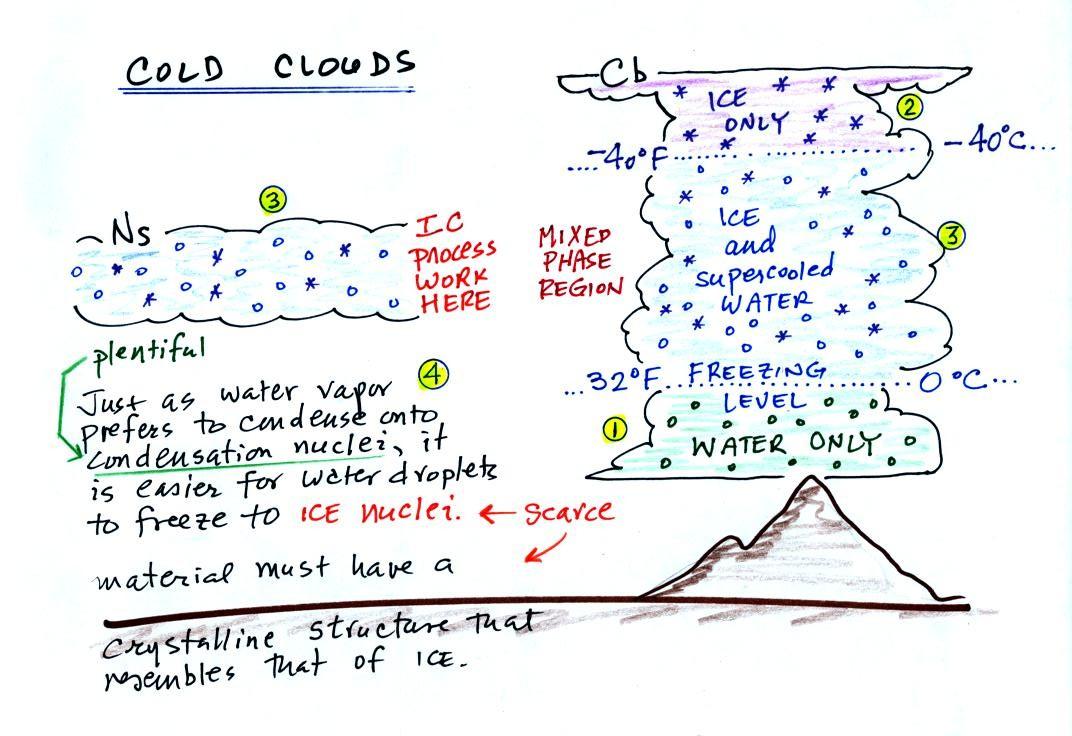
The bottom of the thunderstorm, Point 1, is warm enough
(warmer than freezing) to just contain water droplets. The
top of the thunderstorm, Point 2, is colder than -40 F (which,
coincidentally, is equal to -40 C) and just contains ice
crystals. The interesting part of the thunderstorm and the
nimbostratus cloud is the middle part, Point 3, that contains
both supercooled water droplets (water that has been cooled to
below freezing but hasn't frozen) and ice crystals. This
is called the mixed phase
region. This is where the ice crystal process
will be able to produce precipitation. This is also where
the electrical charge that results in lightning is created.
The supercooled water droplets aren't able to freeze even
though they have been cooled below freezing. At Point 4 we
see this is because it is much easier for small droplets of
water to freeze onto an ice crystal nucleus (just like it is
easier for water vapor to condense onto condensation nuclei
rather than condensing and forming a small droplet of pure
water). Not just any material will work as an ice nucleus
however. The material must have a crystalline structure
that is like that of ice. There just aren't very many
materials with this property and as a result ice crystal nuclei
are rather scarce. In most of the mixed phase region there
are more water droplets than ice crystals.
Supercooled water
Here are a couple of demonstrations involving supercooled water
that I showed in class. In the first
demonstration, some supercooled water (cooled to -6 F (-21
C)) is poured into a glass bowl sitting at room
temperature. Just pouring the water into the bowl is
enough of a "disturbance" to cause the supercooled water to
freeze. Just bumping a bottle of supercooled water in the second
video is enough to cause the water to freeze. I
don't know why that happens.
Superheated water
It is also possible to superheat water. When
the superheated water is disturbed it suddenly and
explosively boils. This
is potentially dangerous demonstration to attempt, better to
watch a
video online.
Here are a some precautions just in case you're ever tempted to
try an experiment like this.
It is probably easier to superheat distilled water than ordinary
tap water. So you might put two cups of water into a
microwave, one with tap water the other filled with distilled
water. The cup of tap water will probably start boiling
when it is supposed to, i.e. before it can become
superheated. You can watch the tap water and get an idea
of how long you need to heat the distilled water to superheat
it. I suspect impurities in the tap water might act as
nuclei to initiate the boiling.
Then once you think you have superheated the cup of distilled
water be very careful taking it out of the microwave (better yet
leave it in the microwave). Just the slightest disturbance
might start the water boiling. You want your hands, arm,
body and faced covered and protected just in case this
happens. Tape a spoon onto the end of a long stick and put
a little sugar or salt into the spoon. Then drop the salt
or sugar into the cup of superheated water.
Chemists will often use boiling chips to make sure water will
start to boil when it is supposed to (at 212 F) rather than
becoming superheated.
Bubbles in beer or soda
Carbonated drinks all contain dissolved carbon
dioxide. The drink containers are pressurized. When
you open the can or take the cap off the pressure inside is
released and dissolved carbon dioxide gas starts to come out of
solution and forms small bubbles. Often you will see the
bubbles originate at a point on the side or bottom of the
glass. These are nucleation sites and are often small
scratches or defects on the surface of the glass that are filled
with a small bubble of air. When the carbon dioxide comes
out of solution rather than forming a bubble of its own, it
takes advantage of these existing bubbles of air. The
bubble, now a mixture of air and carbon dioxide, grows until it
is able to break free and float to the surface (a little gas is
left behind so the process can start over again).
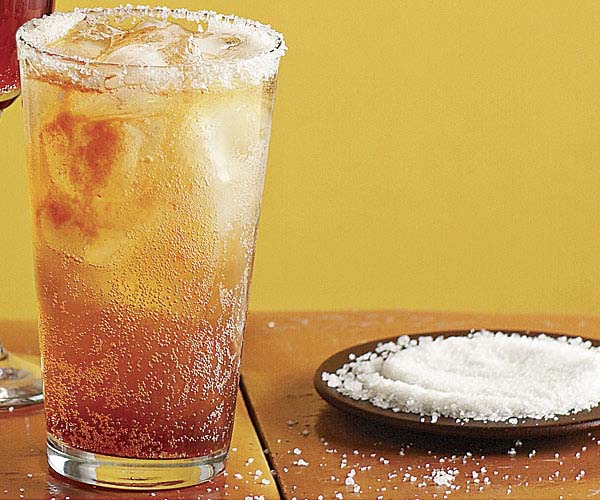
This is actually a beer cocktail of some
kind (image
source) but bubble formation is the same
The next time you are drinking one of these carbonated beverages
sprinkle in a few grains of sugar or salt. These will
serve as additional nucleation site and additional bubbles will
form.
We'll see next why or how the
ice crystal process works, this is the "tricky" part. It's
a 3-step process.
The first figure above (see
p.101 in the photocopied Class Notes) shows a water droplet in
equilibrium with its surroundings. The droplet is
evaporating (the 3 blue arrows in the figure). The rate of
evaporation will depend on the temperature of the water
droplet. There will be some evaporation even from a
droplet that is very cold. The droplet is surrounded by
air that is saturated with water vapor (the droplet is inside a
cloud where the relative humidity is 100%). This means
there is enough water vapor to be able to supply 3 arrows of
condensation. Because the droplet loses and gains water
vapor at equal rates it doesn't grow or shrink.
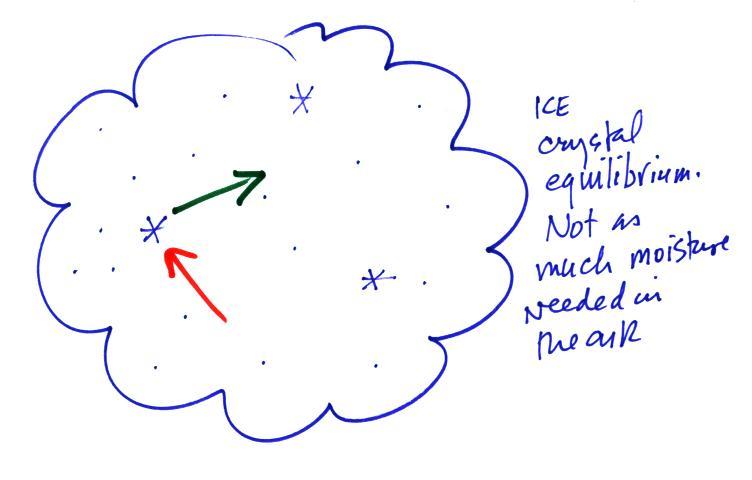
This figure shows what is
required for an ice crystal (at the same temperature) to be in
equilibrium with its surroundings. First, the ice crystal
won't evaporate as rapidly as the water droplet (only 1 arrow is
shown). Going from ice to water vapor is a bigger "jump"
than going from water to water vapor. There won't be as
many ice molecules with enough energy to make that jump. A
sort of analogous situation is shown in the figure below.
The class instructor could and most of the people in the room
could jump from the floor to the top of a 10 or 12 inch tall
box. It would be much tougher to jump to the top of the
table (maybe 30 inches off the ground) or the cabinet (maybe 36
inches) at the front of the room. There wouldn't be as
many people able to do that.
To be in equilibrium the ice crystal only needs 1 arrow of
condensation. There doesn't need to be as much water vapor
in the air surrounding the ice crystal to supply this lower rate
of condensation.
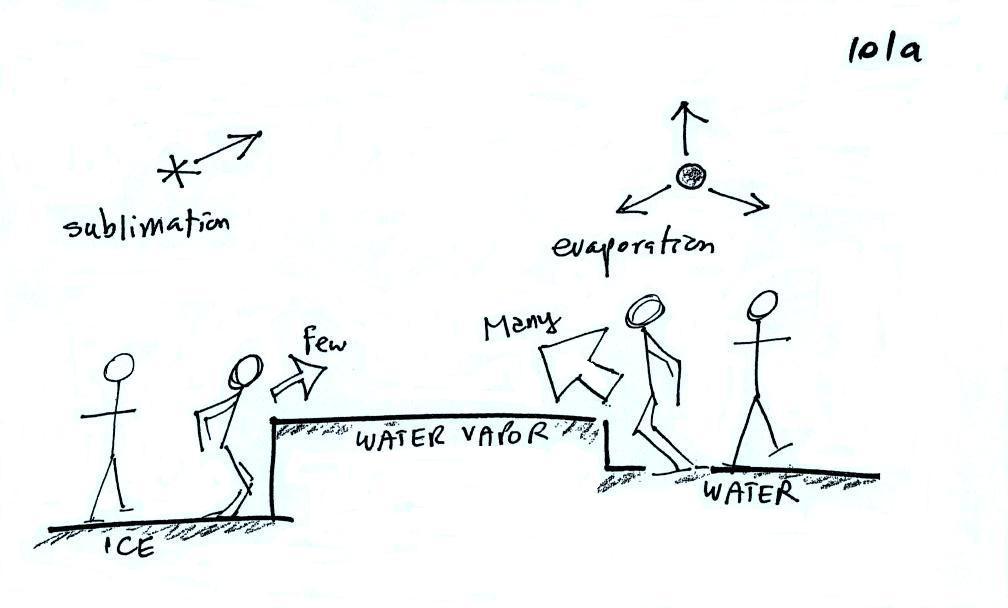
Now what happens in the mixed phase region of a cold
cloud is that ice crystals find themselves in the very moist
surroundings needed for water droplet equilibrium. This is shown
below.
The water droplet is in
equilibrium (3 arrows of evaporation and 3 arrows of
condensation) with the surroundings. The ice crystal is
evaporating more slowly than the water droplet. Because
the ice crystal is in the same surroundings as the water droplet
water vapor will be condensing onto the ice crystal at the same
rate as onto the water droplet. The ice crystal isn't in
equilibrium, condensation (3 arrows) exceeds evaporation (1
arrow) and the ice crystal will grow. That's what
makes the ice crystal process work.
The equal rates of condensation are shown in the figure
below using the earlier analogy.
Most everyone can manage to make the big or the small jump down.
Now
we will see what can happen once the ice crystal has had a
chance to grow a little bit.
Once an ice crystal has grown a little
bit it becomes a snow crystal (this figure is on p. 102 in the
ClassNotes). Snow crystals can have a variety of shapes
(plates, dendrites, columns, needles, etc.; these are called
crystal habits) depending on the conditions (temperature and
moisture) in the cloud. Dendrites are the most common
because they form where there is the most moisture available
for growth. With more raw material available it makes
sense there would be more of this particular snow crystal
shape.
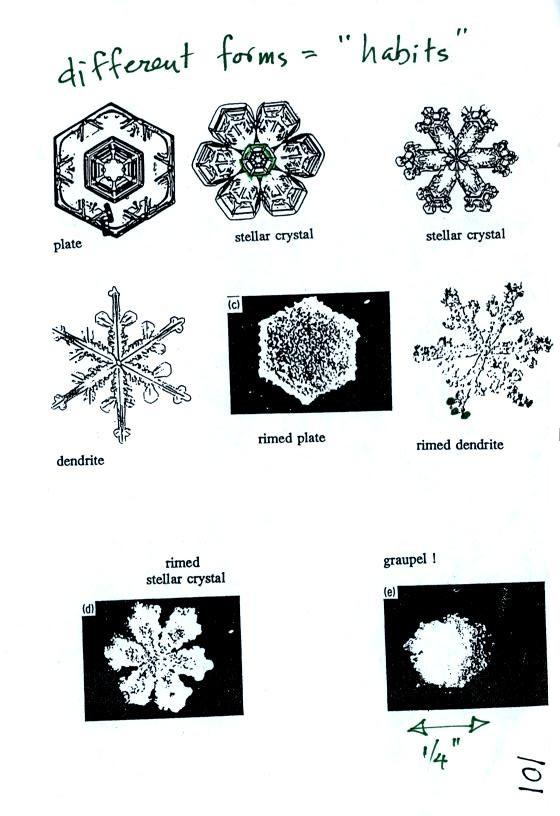
Here
are some actual photographs of snow crystals (taken with a
microscope). They're in the ClassNotes but weren't shown
in class. Snow crystals are usually 100 or a few 100s
of micrometers in diameter (tenths of a millimeter in
diameter). That's visible but you'd need a microscope to
see the detail shown above. The different shapes are
called "habits".
You'll find some much better photographs and a pile of
additional information about snow crystals at www.snowcrystals.com.
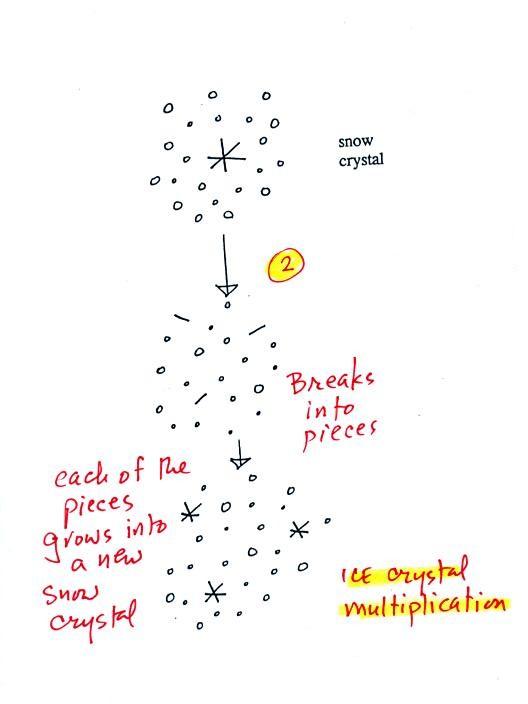
A variety of things can happen once a
snow crystal forms. First it can break into pieces, then
each of the pieces can grow into a new snow crystal.
Because snow crystals are otherwise in rather short supply,
ice crystal multiplication is a way of increasing the amount
of precipitation that ultimately falls from the cloud.
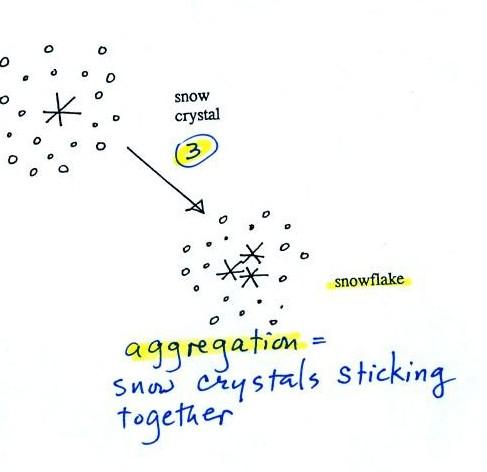
Several snow crystals can collide and
stick together to form a snowflake. Snow crystals are
small, a few tenths of a millimeter across. Snowflakes
can be much larger and are made up of many snow crystals stuck
together. The sticking together or clumping together of
snow crystals is called aggregation (I frequently forget the
name of this process and don't expect you to remember it
either).
The next process and particle are
something that I hope you will remember.
Snow crystals can collide with
supercooled water droplets. The water droplets may stick
and freeze to the snow crystal. This process is called
riming or accretion (note this isn't called collision
coalescence even though it is the same idea). If a snow
crystal collides with enough water droplets it can be
completely covered with ice. The resulting particle is
called graupel. Graupel is sometimes mistaken for hail
and is called soft hail or snow pellets. Rime ice has a
frosty milky white appearance. A graupel particle
resembles a miniature snow ball. Or smaller finer
grained version of the shaved ice in a "snow cone."
Graupel particles often serve as the nucleus for a
hailstone. There are some pretty good pictures of
graupel in this KOMO
news article (KOMO is a Seattle TV
station).
Graupel is made of milky white frosty
rime ice. Sleet, we will find, is made of clear
ice. Here are some pictures to help you better
appreciate the differences in appearance.
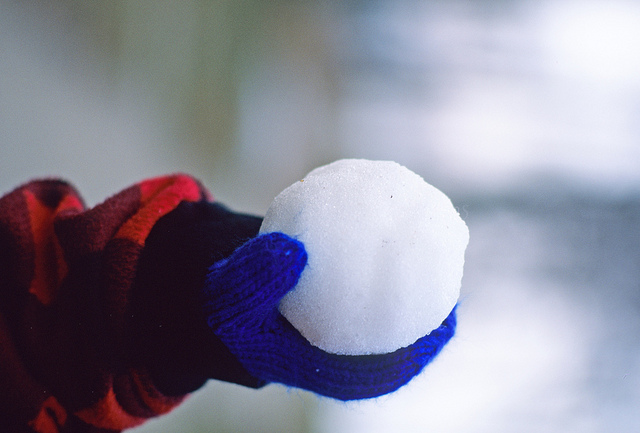
Here's a snowball. It's white
and you can't see through it. It's made up of lots
of smaller crystals of ice. Graupel is just a
small snowball.
source
|
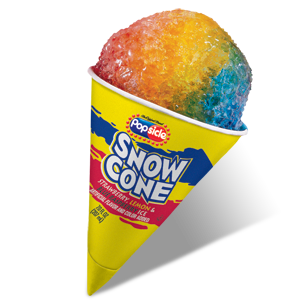
The ice in a snow cone is basically
the same. Lots of smaller chunks of ice.
The ice is frosty white (before you added the flavored
syrup. )
source
|
Graupel is sometimes referred as
snow pellets. Sleet is sometimes called ice pellets.
clear transparent sugar crystals
source of
this photograph
|

frosty white sugar cubes
are made up of many much smaller grains of sugar
|
This figure gives you an idea of
how hail forms.
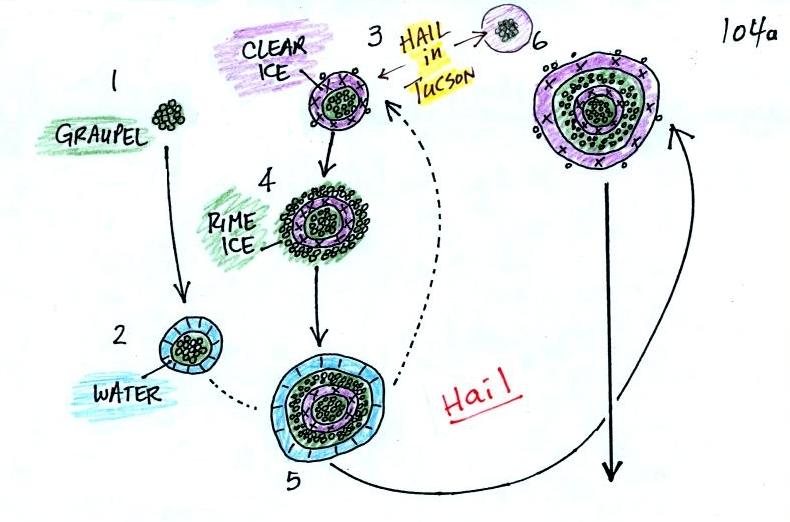
In
the figure above a hailstone starts with a graupel particle
(Pt. 1, colored green to represent rime ice). The
graupel falls or gets carried into a part of the cloud where
it collides with a large number of supercooled water droplets
which stick to the graupel but don't immediately freeze.
The graupel gets coated with a layer of water (blue) at Pt.
2. The particle then moves into a colder part of the
cloud and the water layer freeze producing a layer of clear
ice (the clear ice, colored violet, has a distinctly different
appearance from the milky white rime ice), Pt. 3. In Tucson this is often the only example of hail
that you will see: a graupel particle core with a single layer
of clear ice.
Hail that falls to the ground in Tucson usually just has a
graupel core and a single layer of clear ice. In the
severe thunderstorms in the Central Plains, the hailstone can
pick up additional layers of rime ice and clear ice and
hailstones can be composed of many alternating layers of rime and clear
ice. An unusually large hailstone (around 3 inches
in diameter) has been cut in half to show (below) the
different layers of ice. The picture below is close to
actual size. If something like this were to hit you in
the head it would split your skull open. Here's some
pretty good video of a hailstorm
in Phoenix.
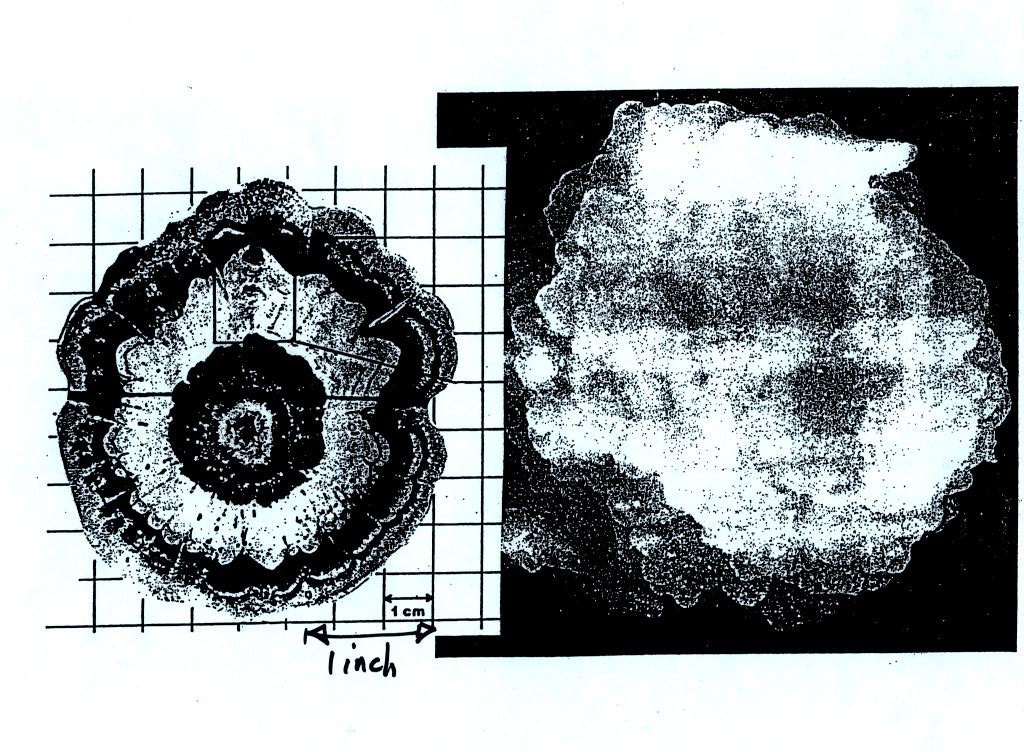
Hail is produced in strong thunderstorms
with tilted updrafts. You would never see hail (or
graupel) falling from a nimbostratus cloud. Here
is a photo of a record setting 8" diameter hailstone
collected in South Dakota. It is currently the national
record holder. Here's
another hailstone that is almost as big. It holds
the record for Oklahoma.
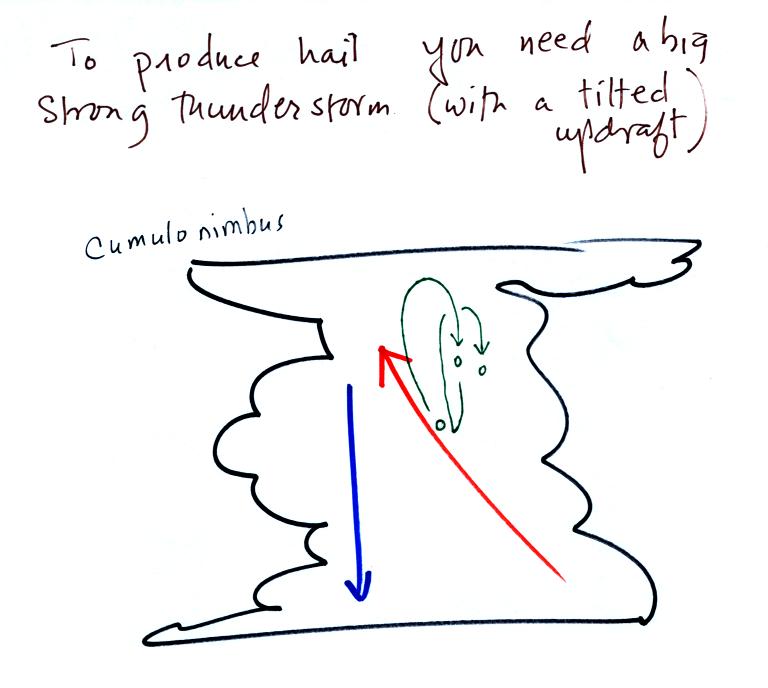
The growing hailstone can fall
back into the updraft (rather than falling out of the cloud)
and be carried back up toward the top of the cloud. In
this way the hailstone can complete several cycles through the
interior of the cloud. The article above mentions a
supercell thunderstorm. We will discuss these later in
the semester.
Finally on p. 103 in the
ClassNotes are illustrations of some of the things that can
happen once a precipitation particle falls from a cloud.
I've split this into two groups for clarity.

Essentially all the rain that
falls in Tucson is produced by the ice crystal process.
The left figure above shows how this happens. A falling
graupel particle or a snow flake moves into warmer air and
melts. The resulting drops of water fall the rest of the
way to the ground and would be called RAIN.
In the middle picture graupel particles can survive the trip
to the ground without melting even in the summer. Many
people on the ground would call this hail but that wouldn't be
quite right. Graupel is less common in the winter because
it comes from thunderstorms and they don't form very often in
the winter. Snow can survive the trip to the ground in the
winter but not the summer.
Sometimes the falling raindrops will evaporate before reaching
the ground. This is called VIRGA and is pretty common
early in the summer thunderstorm season in Arizona when the air
is still pretty dry. Lightning that comes from
thunderstorms that aren't producing much precipitation is called
"dry lightning" and often starts brush fires.
Rain will sometimes freeze before reaching the ground.
The resulting particle of clear ice is called SLEET.
FREEZING RAIN by contrast only freezes once it reaches the
ground. Everything on the ground can get coated with a thick
layer of ice. It
is nearly impossible to drive during one of these "ice
storms." Sometimes the coating of ice is heavy enough
that branches on trees are broken and power lines are brought
down (either by the weight of ice or falling tree limbs).
It sometimes takes several days for power to be
restored. Here's a gallery
of images taken after ice storms.



